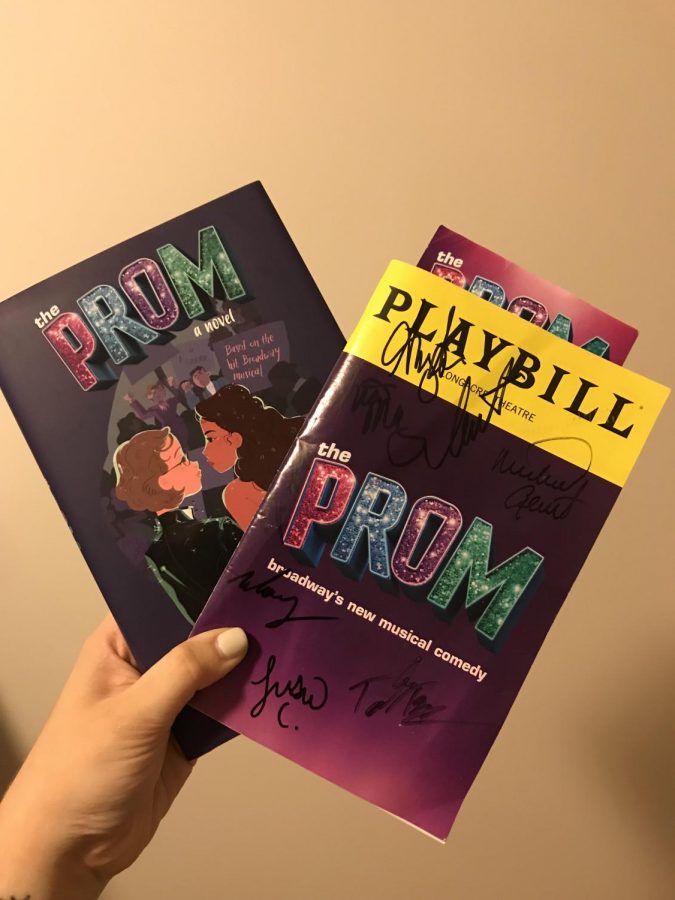“The Prom” made waves on Broadway last season and despite running for less than a year, it’s legacy lives on. A film adaption for Netflix and a national tour are in the works, but a young adult novel based on the show was released in September. Author Saundra Mitchell worked alongside the show’s creators Chad Beguelin, Bob Martin and Matthew Sklar to pen the Penguin Young Readers’ Viking Children’s Books’ adaptation.
“The Prom” follows a 17-year-old girl from Indiana, Emma Nolan, whose senior prom is canceled by the Parent Teacher Association when she tries to bring her girlfriend. The driving force behind the PTA is the mother of Emma’s closeted girlfriend, Alyssa Greene. When four down-on-their-luck Broadway actors hear about Emma’s story, they travel to the Crossroads of America and try to spread acceptance and tolerance; however, their old narcissistic ways lead to shenanigans.
Or, “The Prom” can be viewed as following the tale of Barry Glickman and Dee Dee Allen, who are bashed by a New York Times review, causing their show “Eleanor: The Eleanor Roosevelt Musical” to close on opening night. They team up with their old friends, Trent and Angie, and together decide to take up a cause célèbre to receive good press. After seeing Emma’s story online, they travel to Indiana and once again become too self-involved.
While stage productions are set up with Barry and Dee’s storyline, the young adult novel more closely follows the former narrative and is written in first person, with Emma’s and Alyssa’s point of view switching each chapter. It expands the story from their perspective and goes more in-depth with their initial meeting, relationship and overall experience with the prom debacle. Emma’s backstory is also further explored, with her sharing how she came out, her family situation and how she uses music and YouTube to cope with the extreme bullying at school.
Among the major differences between the musical and novel are the characters. In order to compact the New York side of the story, the characters of Trent and Angie were cut. A few of their main characteristics and plot points are merged with Barry or Dee Dee’s character, like Trent’s experience with the 1990s sitcom “Talk to the Hand” is now Barry’s and instead of Angie encouraging Emma to find her inner “zazz,” Dee Dee does.
If you go into the novel expecting Chad Beguelin and Bob Martin’s book of the musical comedy, you’ll find much of that humor missing. “The Prom” was named a New York Times’ Critics Pick and was often called the funniest show on Broadway. In his review for the NYT, Jesse Green writes it “is such a joyful hoot. With its kinetic dancing, broad mugging and belty anthems, it makes you believe in musical comedy again.” However, the story loses quite a bit of its comedic element in the novel. The story of an LBTGQ teen in middle America is an important story to tell, and at times it is hard to see the pain Emma goes through, but the humor made it easier to swallow. With less scenes containing the actors from New York, the story loses its signature comedic moments and ongoing jokes, such as Trent bringing up the fact he went to Julliard at any chance he gets.
One of the great things about “The Prom” is the satisfying ending; everyone’s character grows and learns from everyone else. The ending of the novel doesn’t quite pack the same punch. The endings are similar, but in the format of the musical comedy, the heart of gold ending shines brighter. With more characters and more plot lines, everything seems a bit chaotic and there are more stakes involved. Whereas, in the novel, it is expected that the conflict will resolve nicely, considering the majority of the plot revolves around these two teenagers.
Due to the format change, Dee Dee’s and Barry’s character development lacks in the novel. They’re painted one dimensionally and not much room is given for their growth. In the musical, Dee Dee’s character is crafted to become lovable. She lives in a bubble and can be out of touch with reality, but throughout her time spent with the high school’s principal, Mr. Hawkins, and Emma, she learns how to take interest and care about others. In the novel, both Emma and Alyssa depict her as an intimidating, vain actress, and that’s about it. Barry’s depiction is truer to his character in the musical, but still falls flat. Actors Brooks Ashmanskas and Beth Leavel had Barry and Dee Dee written for them and have often described the characters as heightened versions of themselves. Not to say these characters can’t stand on their own on the written page, but their characters aren’t done justice.
The novel also includes a few pieces of bonus material. Two Q&As from the fictional media outlet, Broadway Scores!, with Barry and Dee Dee act as book ends to the story, and a snippet of the NYT review originally mentioned in the Broadway musical, “If FDR Could Stand for This, He Wouldn’t,” is printed. These supplements help introduce the two characters and gives them more closure than the story itself while giving the novel a little more humor.
If you want a heartwarming story, that’s what you get with Saundra Mitchell’s adaptation. It captures a moment of homophobia in middle America and uses it as a teaching opportunity. By the end, people love and accept Emma and Alyssa or at the very least, are able hear them out and participate in discussions about changing their beliefs. Despite the lack of musical numbers, the celebration of musicals does transfer to the pages through small hints, like names of chapters and quick references dropped. While the novel does not fully explore the universe of “The Prom,” it acts as a great way in and gives readers key elements of the musical.
Abigail Charpentier can be reached at [email protected] and followed on Twitter @abigailcharp.




















